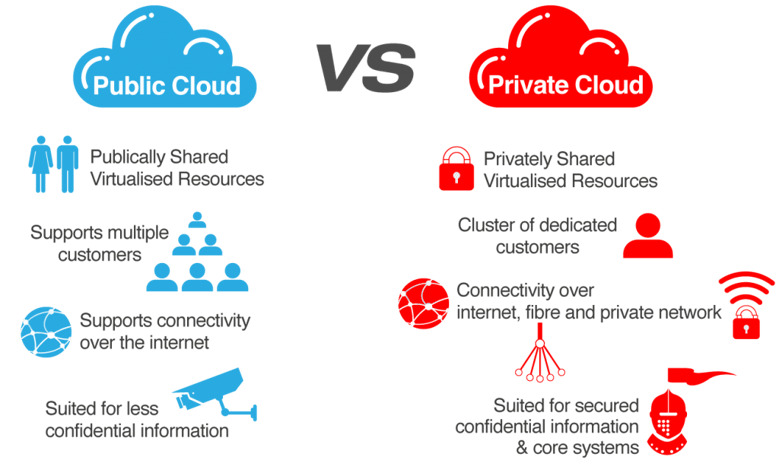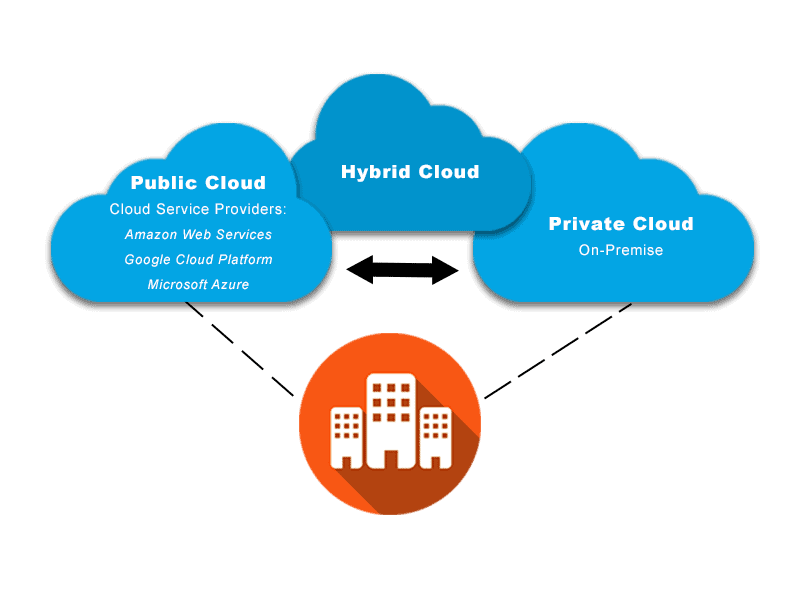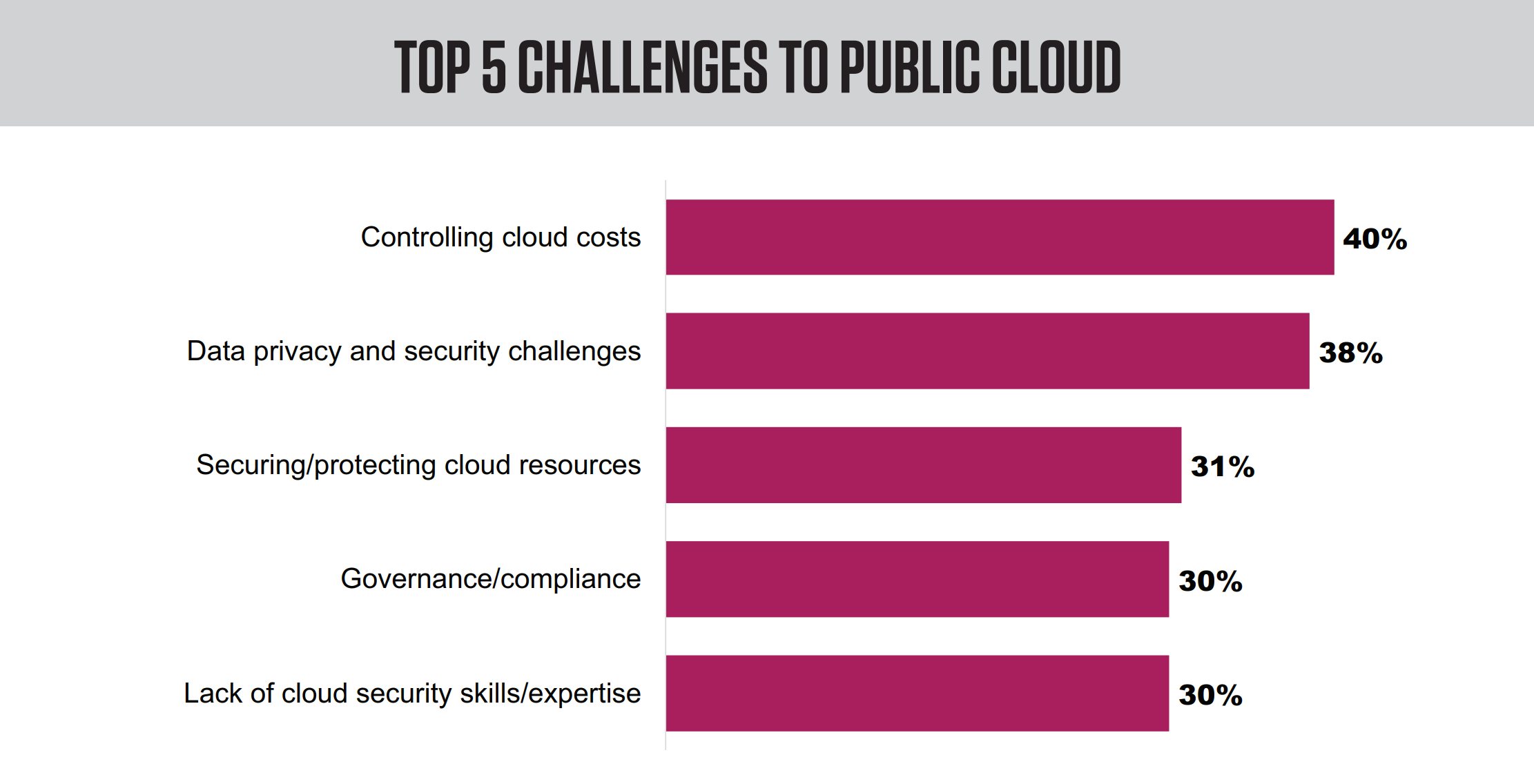Even before COVID-19 knocked the world off its axis, cloud computing was quickly emerging as the way global businesses would operate in the future.
Many millions of dollars and thousands of hours have been invested by organizations into on-premises infrastructure over the past few decades. But it's becoming clear now that the most efficient and effective digital transformation solutions involve a blend of private and public cloud (hybrid cloud) initiatives.
In this guide, we'll explain what a hybrid cloud infrastructure is, what it takes to set it up, and the benefits that a well-planned and executed hybrid cloud architecture will bring to any business. We'll cover the differences between private clouds and public clouds and the things you should expect from your cloud provider when embarking on a hybrid cloud setup.
 Image source: NetData
Image source: NetData
Read our 'UC Cloud Migration Checklist'
What is a hybrid cloud?
A hybrid cloud environment utilizes a mix of on-premises infrastructure, private cloud and third party public cloud services (like Microsoft Azure or Amazon Web Services (AWS) that operate between these platforms.
A hybrid cloud infrastructure involves the ability to link between an on-premises data center to a public cloud and/or other private assets, including edge devices and other clouds via data virtualization, then through connected devices and applications like VPNs, APIs, and WANs. The connection of all these devices and applications into a hybrid cloud means a business can manage a wide range of data, and can have greater control of data security and availability.
A digital business operates on the core principles of flexibility and agility. These are the key beneficial features of hybrid cloud, so the ability to manipulate workloads between private and public clouds is an ideal way for organizations to stay current and competitive.
Difference between public clouds and private clouds
Before we look deeper into hybrid cloud benefits, let's take a look at the key differences/advantages/disadvantages between private cloud and public cloud.
 Image source: AVInetworks
Image source: AVInetworks
Public Cloud
If you've opted for cloud providers such as AWS or Azure, you’re using public cloud services, which essentially means leasing a slice of their distributed data center infrastructure. Public clouds work by delivering fully automated Cloud Infrastructure as a Service (IaaS), providing massive economies of scale, so on-premises data centers could never compare with cost savings or efficiency.
Public cloud advantages:
-
Public cloud environments offer practically unlimited scalability (both up and down) due to on-demand public cloud resources.
-
Capital expenditure (Capex) is kept to a minimum as there is no need to purchase data center equipment.
-
The fact that services are distributed across multiple data centers, means that public cloud services are far more reliable.
Public cloud disadvantages:
-
As public cloud data centers can be widely geographically dispersed or otherwise restricted, businesses may have less control over data security.
-
Public clouds can attract higher operational expenditure (Opex). As businesses scale performance, the cost-per-hour fees can rise.
Private Cloud
A dedicated private cloud infrastructure is so called whether it's managed by the enterprise, or by third-party private cloud services, and whether it's hosted on-premises or off-premises.
Private cloud advantages:
-
With private clouds, all data and applications remain behind your firewall and can only be accessed by your enterprise. Arguably, this means that private clouds better suited for security management when processing or storing sensitive data.
-
Potentially lower Total Cost of Ownership (TCO) due to lower Opex over time.
-
Private clouds tend to allow greater control and customization through the ability to tailor servers to your enterprise’s preferences.
-
Private clouds also offer flexibility by allowing 'cloud bursting', or the option to move non-sensitive data to a public cloud to accommodate sudden increased demand on your private cloud.
Disadvantages:
-
There could be increased initial charges through capital expenditure, and the need to repay costs of the equipment needed.
-
The responsibility for operating and maintaining your own data center, IT hardware and software as well as security and compliance can be an unwanted burden
-
There is less flexibility in scaling cloud resources up or down as your business needs fluctuate.
Hybrid clouds vs. multi-clouds: What's the difference?
While the terms hybrid cloud and multi-cloud are similar, there are differences. With multi-cloud, an organization uses the services of multiple public clouds, usually from different cloud providers. For example, an organization might host its front-end web application on Amazon Web Services, and its Exchange servers on Microsoft Azure.
All public cloud providers are different, offering a variety of features, so organizations adopt a multi-cloud strategy to utilize best-of-breed IT services, and prevent the need to be tied to a single cloud provider.
 Image source: TechTarget
Image source: TechTarget
The other distinction between a hybrid cloud approach and multi-clouds is that a hybrid cloud setup always includes a private cloud and this environment is managed as one entity.
Multi-clouds consist of more than one public cloud service, often performing different functions, and do not need to include a private cloud component, but if they do, they are classed as both multi-cloud and hybrid cloud.
How can a business benefit from hybrid cloud architecture?
Having examined the differences between a public and private cloud environment, and taking into account the pros and cons of each, its clear why many organizations are choosing a hybrid mix of cloud services when deciding on which environment is right for them.
As we've mentioned, a hybrid cloud refers to to a combined environment of computing and storage services made up of on-premises architecture, private and public cloud that utilize existing data infrastructure within an organization. In essence, hybrid clouds work by providing the best of on-premises IT and cloud computing.
Even though there could potentially be considerable investment and effort involved in setup, here are some of the main benefits of a hybrid cloud strategy that make it a valuable investment for enterprises.
 Image source: TechTarget
Image source: TechTarget
Better cost management
By connecting between public and private clouds, an enterprise can keep better control over its costs. When local demand stresses capacity, an organization can draw on additional resources of the public cloud (cloud bursting) to help smooth those spikes in demand.
By integrating private cloud resources for critical data and workloads, and public cloud for temporary, general-purpose, disaster recover or experimental workloads, this hybrid cloud approach means you can run workloads where costs are lowest.
Hybrid cloud can also clearly reveal on where IT expenditure goes. A hybrid cloud can make it easy to account for IT consumption in capital and operational costs. Enterprises can use third party monitoring tools to keep close track of cloud usage with detailed reports on utilization and costs by workload, manager, department, or other criteria.
Hybrid cloud is scalable and flexible
Agility and consistency are major benefits of hybrid cloud. It's easier to create workloads and resources, and to shift and scale them if the private cloud offers services similar to those available in the chosen public. This consistency enables organizations to provision and use private cloud resources when they need to and where it's most cost-effective, then easily draw upon additional resources from the public cloud when necessary.
Security
An enterprise's data and workloads are vital assets, so security is a core concern for enterprise IT teams. A major security concern in a public arena is that the infrastructure belongs exclusively to the cloud provider, meaning that users can't see or control the entire cloud infrastructure. While a cloud provider is responsible for securing a user's cloud environment and data storage, they are rarely responsible when a data breach or other malicious activity occurs.
Keeping sensitive data on premises is the best approach in many cases. With combined public and private clouds, enterprises gain some common hybrid cloud oversight.
Uniformity
Theoretically, hybrid clouds support greater standardization in IT management practices. But organizations often struggle to create that uniformity. IT staff are often left trying to operate a private infrastructure, while developing workflows that are consistent with both private and public frameworks.
Top cloud providers have become more sensitive to the importance and benefits of hybrid cloud, as well as the challenges of integrating private and public environments, so most now offer various services that focus on hybrid needs
Maintain regulatory governance and compliance
A hybrid approach allows organizations to decide where their applications sit and where hybrid computing happens. This can help with privacy concerns, and ensure compliance for all regulated applications. Many industries have rules surrounding where an application can operate. Hybrid can help by combining public and private to keep to any regulatory requirements.
Facilitate IT staff and resources to accommodate growth
A fast growing business may not have the IT staff to support all of the necessary IT resources. With hybrid cloud, your public cloud service provider is on hand to offer on demand cloud resources as part of their services. By utilizing the knowledge and experience of public providers, businesses can leverage their internal IT staff to attend to more productive areas.
Addressing the challenges of a hybrid cloud architecture
While there are a few challenges with building a hybrid cloud model, such as architectural complexity, security issues, cost control and troubleshooting problems, organizations can use several hybrid cloud solutions to help mitigate the disadvantages, and enhance the success of any hybrid cloud project.
 Image source: BPI
Image source: BPI
Monitoring with IR Collaborate
Without complete visibility, accountability and control throughout hybrid cloud environments organizations face obstacles that will outweigh the benefits when deploying cloud solutions.
No matter what hybrid cloud solution your organization is using, data and analytics are crucial to understanding how systems are performing within a hybrid computing environment. Just as important is end-user performance.
Being able to see every level of your hybrid cloud ecosystem provides multiple layers of intelligence and insights that have many benefits, including providing analytics that can help you create team cohesion, more effective cost management, innovation, and growth.
Find out how IR Collaborate can help make your hybrid cloud environment foolproof.




